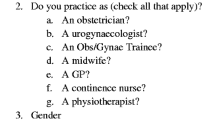Abstract
It is not uncommon to be challenged with the dilemma of deciding the best mode of delivery in a patient with a history of previous pelvic floor surgery. We hypothesized that the trend would be a predilection towards cesarean section delivery in the context of a previous pelvic floor surgery, especially amongst Urogynaecologists. A nation-wide survey was sent through the Society of Obstetrics and Gynaecology of Canada to all physician members to assess the practice patterns regarding the preferred mode of delivery after pelvic floor surgery. A hundred and three members replied. Forty-seven percent would recommend a cesarean section (CS) when pregnant after a previous midurethral sling (MUS), 27.2 % would allow vaginal delivery, 10.7 % would not be affected in their decision by the MUS, 9.7 % would strongly advise against pregnancy and 4.9 % would suggest a cesarean section with a sterilization procedure. With a history of previous pelvic organ prolapse surgery (POP), 54.4 % would suggest a CS when pregnant, 21.4 % would strongly advise against pregnancy and only 15.5 % would allow the patient to deliver vaginally. Urogynaecologists are significantly more likely to strongly advise a patient with a previous MUS against pregnancy, compared to their peers practicing general obstetrics and gynaecology (OBGYN) (p = 0.04) or maternal fetal medicine (MFM) (p = 0.05). Larger studies and clear guidelines advising physicians to the optimum mode of delivery following a history of previous pelvic floor surgery are strongly needed.




Similar content being viewed by others
References
Elenskaia K, Thakar R, Sultan AH, Scheer I, Onwude J (2013) Effect of childbirth on pelvic organ support and quality of life: a longitudinal cohort study. Int Urogynecol J 24(6):927–937
Koc O, Duran B (2012) Role of elective cesarean section in prevention of pelvic floor disorders. Curr Opin Obstet Gynecol 24(5):318–323
Hannestad YS, Rortveit G, Sandvik H, Hunskaar S (2000) A community-based epidemiological survey of female urinary incontinence: the Norwegian EPINCONT study. Epidemiology of Incontinence in the County of Nord-Trondelag. J Clin Epidemiol 53(11):1150–1157
Handa VL, Harvey L, Fox HE, Kjerulff KH (2004) Parity and route of delivery: does cesarean delivery reduce bladder symptoms later in life? Am J Obstet Gynecol 191(2):463–469
Balasch J, Gratacos E (2012) Delayed childbearing: effects on fertility and the outcome of pregnancy. Curr Opin Obstet Gynecol 24(3):187–193
Leijonhufvud A, Lundholm C, Cnattingius S, Granath F, Andolf E, Altman D (2011) Risks of stress urinary incontinence and pelvic organ prolapse surgery in relation to mode of childbirth. Am J Obstet Gynecol 204(1):70 e1–70 e7
Gyhagen M, Bullarbo M, Nielsen TF, Milsom I (2013) A comparison of the long-term consequences of vaginal delivery versus caesarean section on the prevalence, severity and bothersomeness of urinary incontinence subtypes: a national cohort study in primiparous women. BJOG 120(12):1548–1555
Panel L, Triopon G, Courtieu C, Mares P, de Tayrac R (2008) How to advise a woman who wants to get pregnant after a sub-urethral tape placement? Int Urogynecol J Pelvic Floor Dysfunct 19(3):347–350
Cavkaytar S, Kokanali MK, Ozer I, Erkilinc S, Aksakal OS, Doganay M (2015) Effect of pregnancy and delivery on urinary incontinence after the midurethral sling procedure. Int Urogynecol J 26(5):693–698
Seeger D, Truong ST, Kimmig R (2006) Spontaneous delivery following tension-free vaginal tape procedure. Int Urogynecol J Pelvic Floor Dysfunct 17(6):676–678
Maher CF, Carey MP, Murray CJ (2001) Laparoscopic suture hysteropexy for uterine prolapse. Obstet Gynecol 97(6):1010–1014
Rahmanou P, Price N, Black RS, Jackson SR (2014) Pregnancy post-laparoscopic hysteropexy. J Obstet Gynaecol 1–2 35(3):303–304
Weimiao F, Zheng Y (2010) Factors affecting response rates of the web survey: a systematic review. Comput Hum Behav 26(2):132–139
Author information
Authors and Affiliations
Corresponding author
Ethics declarations
This article does not contain any studies with human participants or animals performed by any of the authors.
Conflict of interest
Ola Malabarey declares that she has no conflict of interest.
Lucia Farisello declares that she has no conflict of interest.
Lauren Gazzard declares that she has no conflict of interest.
Jens-Erik Walter is a consultant for Boston Scientific and sometimes accepts paid travel expenses and honoraria from the company.
Rights and permissions
About this article
Cite this article
Malabarey, O., Farisello, L., Gazzard, L. et al. Results of a nationwide survey on practice patterns of Canadian obstetricians and gynaecologists regarding the mode of delivery after pelvic floor surgery. Gynecol Surg 13, 159–164 (2016). https://doi.org/10.1007/s10397-016-0935-7
Received:
Accepted:
Published:
Issue Date:
DOI: https://doi.org/10.1007/s10397-016-0935-7




